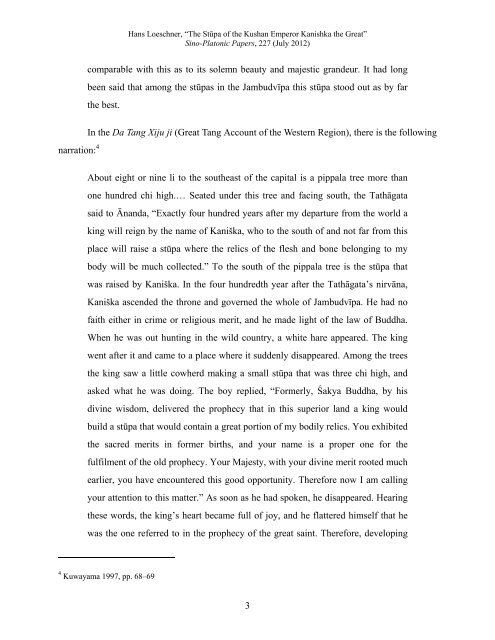The Stūpa of the Kushan Emperor Kanishka the - Sino-Platonic Papers
The Stūpa of the Kushan Emperor Kanishka the - Sino-Platonic Papers
The Stūpa of the Kushan Emperor Kanishka the - Sino-Platonic Papers
Create successful ePaper yourself
Turn your PDF publications into a flip-book with our unique Google optimized e-Paper software.
narration: 4<br />
Hans Loeschner, “<strong>The</strong> <strong>Stūpa</strong> <strong>of</strong> <strong>the</strong> <strong>Kushan</strong> <strong>Emperor</strong> <strong>Kanishka</strong> <strong>the</strong> Great”<br />
<strong>Sino</strong>-<strong>Platonic</strong> <strong>Papers</strong>, 227 (July 2012)<br />
comparable with this as to its solemn beauty and majestic grandeur. It had long<br />
been said that among <strong>the</strong> stūpas in <strong>the</strong> Jambudvīpa this stūpa stood out as by far<br />
<strong>the</strong> best.<br />
In <strong>the</strong> Da Tang Xiju ji (Great Tang Account <strong>of</strong> <strong>the</strong> Western Region), <strong>the</strong>re is <strong>the</strong> following<br />
About eight or nine li to <strong>the</strong> sou<strong>the</strong>ast <strong>of</strong> <strong>the</strong> capital is a pippala tree more than<br />
one hundred chi high.… Seated under this tree and facing south, <strong>the</strong> Tathāgata<br />
said to Ānanda, “Exactly four hundred years after my departure from <strong>the</strong> world a<br />
king will reign by <strong>the</strong> name <strong>of</strong> Kaniška, who to <strong>the</strong> south <strong>of</strong> and not far from this<br />
place will raise a stūpa where <strong>the</strong> relics <strong>of</strong> <strong>the</strong> flesh and bone belonging to my<br />
body will be much collected.” To <strong>the</strong> south <strong>of</strong> <strong>the</strong> pippala tree is <strong>the</strong> stūpa that<br />
was raised by Kaniška. In <strong>the</strong> four hundredth year after <strong>the</strong> Tathāgata’s nirvāna,<br />
Kaniška ascended <strong>the</strong> throne and governed <strong>the</strong> whole <strong>of</strong> Jambudvīpa. He had no<br />
faith ei<strong>the</strong>r in crime or religious merit, and he made light <strong>of</strong> <strong>the</strong> law <strong>of</strong> Buddha.<br />
When he was out hunting in <strong>the</strong> wild country, a white hare appeared. <strong>The</strong> king<br />
went after it and came to a place where it suddenly disappeared. Among <strong>the</strong> trees<br />
<strong>the</strong> king saw a little cowherd making a small stūpa that was three chi high, and<br />
asked what he was doing. <strong>The</strong> boy replied, “Formerly, Śakya Buddha, by his<br />
divine wisdom, delivered <strong>the</strong> prophecy that in this superior land a king would<br />
build a stūpa that would contain a great portion <strong>of</strong> my bodily relics. You exhibited<br />
<strong>the</strong> sacred merits in former births, and your name is a proper one for <strong>the</strong><br />
fulfilment <strong>of</strong> <strong>the</strong> old prophecy. Your Majesty, with your divine merit rooted much<br />
earlier, you have encountered this good opportunity. <strong>The</strong>refore now I am calling<br />
your attention to this matter.” As soon as he had spoken, he disappeared. Hearing<br />
<strong>the</strong>se words, <strong>the</strong> king’s heart became full <strong>of</strong> joy, and he flattered himself that he<br />
was <strong>the</strong> one referred to in <strong>the</strong> prophecy <strong>of</strong> <strong>the</strong> great saint. <strong>The</strong>refore, developing<br />
4 Kuwayama 1997, pp. 68–69<br />
3

















